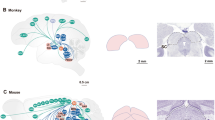Abstract
The responses of neurons in the ventrolateral nucleus (VL) of the thalamus were studied in humans during performance of voluntary motor tests; recordings were made with microelectrodes during stereotaxic operations in patients with Parkinson's disease. Two previously classified types of polyvalent neurons (A, B) were found to show different patterns of responses during the functional stages of carrying out a voluntary movement (preparation, initiation, performance). A and B neurons showed concordant changes in the dynamics of ongoing network activity in the form of linked (activation-inhibition) and synergic (activation) response patterns, correlating with the preparation-trigger and performance phases of movements. It is suggested that the simultaneous activity of both types of neuron, with their common functional nature, reflects integrative processes occurring in the ventrolateral nucleus and associated with programming and processing of general signal parameters but not with the performance of any particular movement. The anterior (Voa nucleus) and posterior (Vop) parts of the ventrolateral nucleus were found to have different roles in organizing voluntary movements, associated with differences in their cellular organization and mechanisms of transmitting motor signals. It is suggested that the concordant changes in the activities of the two types of neurons in these areas seen during the performance of voluntary movements gives the ventrolateral nucleus a key role in the motor control system in humans.
Similar content being viewed by others
References
S. N. Raeva,Microelectrode Studies of Human Brain Activity [in Russian], Nauka, Moscow (1977).
S. N. Raeva, “Neuronal mechanisms for translating words into voluntary actions,”Fiziol. Cheloveka,15, No. 3, 40–52 (1989).
S. N. Raeva, N. A. Vainberg, and V. A. Dubynin, “Features of the spontaneous activity of single neurons in the human ventrolateral thalamus on changes in the functional state of the brain,”Ros. Fiziol. Zh. im. I. M. Sechenova,83, No. 8, 24–32 (1997).
S. N. Raeva, A. O. Lukashev, A. P. Lashin, N. Ya. Vasin, A. L. Kadin, V. A. Shabalov, and N. P. Grokhovskii, “Responses of neuronal in the reticular nucleus of the human thalamus during speech and sensory stimuli of different signal meaning,”Neirofiziologiya,22, No. 4, 441–451 (1990).
D. Albe-Fessard, G. Guiot, Y. Lamarre, and G. Arfel, “Activation of thalamocortical projections related to tremorogenic processes,” inThe Thalamus, D. P. Purpura and M. D. Yahr (Eds.), Columbia University Press, New York, London (1996), pp. 237–253.
R. M. Crowell, E. Perret, J. Siegfried, and J.-P. Villoz, “Movement units' and ‘tremor phasic units’ in the human thalamus,”Brain Res.,11, 481–488 (1968).
E. V. Evarst, “Activity of thalamic and cortical neurons in relation to learned movement in the monkey,”Int. J. Neurol.,8, 321–326 (1971).
A. Hongell, G. Walvling and K. E. Hagbarsth, “Unit activity connected with movement and arousal situation recorded from the ventrolateral nucleus of the human thalamus,”Acta Neurol. Scand.,49, 681–698 (1973).
H. H. Jasper and G. Bertrand, “Thalamic units involved in somatic sensation and voluntary and involuntary movement in man,” in:The Thalamus, D. P. Purpura and M. D. Yahr (Eds.), Columbia University Press, New York, London (1996), pp. 365–390.
E. G. Jones,The Thalamus, Plenum Press, New York (1985).
A. I. Joffroy and Y. Lamarre, “Single-cell activity in the ventral lateral thalamus of the unanesthetized monkey,”Exp. Neurol.,42, 1–16 (1974).
F. A. Lenz, H. C. Kwan, J. O. Dostrovsky, R. R. Tasker, J. T. Murphy, and Y. E. Lenz, “Single-unit analysis of the human ventral lateral nuclear group: activity correlated with movement,”Brain,113, 1795–1821 (1990).
F. A. Lenz, H. C. Kwan, J. O. Dostrovsky, and R. R. Tasker, “Characteristics of the bursting pattern of action potentials that occurs in the thalamus of patients with central pain,”Brain Res.,496, 357–360 (1989).
J. Massion, “The thalamus in the motor system,”Appl. Neurophysiol.,39, 222–238 (1976–7).
J. Macpherson, D. Rasmussen, and J. Murphy, “Activities of neurons in ‘motor’ thalamus during control of limb movement in primate,”J. Neurophysiol.,4, No. 1, 11–28 (1980).
K. Nakano, Y. Hasegawa, T. Kayachara, A. Tokushige, and Y. Kuga, “Cortical connections of the motor thalamic nuclei in the Japanese monkeyMacaca fuscata,”Stereotact. Funct. Neurosurg.,60, 42–91 (1993).
Ch. Oyhe, “Depth microelectrode studies,” in:Stereotaxy of the Human Brain: Anatomical, Physiological, and Clinical Applications, G. Schaltenbrand and A. E. Waler (Eds.), Georg Thime Verlag, Stuttgart, New York (1982), pp. 372–389.
G. Percheron, C. Francois, B. Talbi, J. F. Meder, G. Fenelon, and J. Yelmik, “The primate motor thalamus analyzed with reference to subcortical afferent territories,”Stereotact. Funct. Neurosurg.,60, 32–41 (1993).
S. Raeva, “Unit activity of some deep nuclear structures of the human brain during voluntary movements,” in:Neurophysiology Studied in Man, G. Sonjen (Ed.), Excerpta Medica, Amsterdam (1972), pp. 64–78.
S. Raeva, “Localization in human thalamus of units triggered during ‘verbal commands’, voluntary movements, and tremor,”EEG Clin. Neurophysiol.,63, 160–173 (1986).
S. Raeva, “Unit activity of nucleus ventrials lateralis of human thalamus during voluntary movements,”Stereotact. Funct. Neurosurg.,60, 86–93 (1993).
P. Strick, “Activity of ventrolateral thalamic neurons during arm movement,”J. Neurophysiol.,39, No. 5, 1032–1044 (1976).
R. Tasker, F. A. Lenz, G. Dostrovsky, K. Yamashiro, G. Chodakiewitz, and D. Albe-Fessard, “The physiological basis of Vim thalamotomy for involuntary movement disorders,” in:Clinical Aspects of Sensory and Motor Integration, A. Struppler and A. Weindl (Eds.), Springer Verlag, Berlin, Heidelberg (1987), pp. 265–276.
Author information
Authors and Affiliations
Additional information
Translated from Rossiiskii Fiziologicheskii Zhurnal imeni I. M. Sechenova, Vol. 84, No. 7, pp. 603–613, July, 1998.
Rights and permissions
About this article
Cite this article
Raeva, S.N., Vainberg, N.A., Dubynin, V.A. et al. Changes in the spike activity of neurons in the ventrolateral nucleus of the thalamus in humans during performance of a voluntary movement. Neurosci Behav Physiol 29, 505–513 (1999). https://doi.org/10.1007/BF02461142
Received:
Issue Date:
DOI: https://doi.org/10.1007/BF02461142




